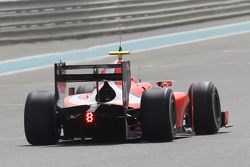The lowdown: How GP2’s new DRS system works
Formula One feeder series Technical Director Didier Perrin tells us how drag-reduction system will work this year.

Photo by: Motorsport Images




Didier, you’ve been working on the DRS throughout the winter, what can you tell us about it?
“It’s been a very busy winter to say the least! It was interesting to introduce a new technical device on our GP2/11 cars. Ever since we decided to add the DRS, our target was to produce one that would be similar to the one used in Formula One but that would be easy to operate and affordable for GP2."
What was the design process?
“We started to design the system during the summer of 2014 and we tested it for the first time on track in October at the Circuit de Catalunya. We developed it further that same month in Barcelona again. Then we did two tests sessions of five days each in Bahrain, first in December and then in February. Our main goal was to make sure we would provide our teams with a reliable system.
“During our tests in Bahrain, we achieved quite a lot of mileage. Little by little, we simplified the system: we started with something which was pretty complex but we ended up with a device that’s pretty straightforward. That was important because the simpler it is, the easier it is to operate and to be reliable and efficient.”
How does the GP2 DRS compares to the one used in F1?
“The rules and the way we operate it is similar to F1. We will have the same DRS zones as the ones in F1. The detection line where we measure the gap between the cars will be in the same location and the criteria to allow a driver to use the DRS or not will be exactly the same as in F1.
“The main difference resides in the telemetry. In F1, the teams have at their disposal a very competitive telemetry system which sends and receives data from the car. Of course, that’s not something that we have in GP2.
“Therefore, we had to develop a telemetry system which will be managed by EM Motorsport. It will enable to localise the cars on track and send the DRS data to each of them during every sessions."
How will the DRS impact the teams?
“It will mainly impact the strategy for both the teams and the drivers: obviously, at the end of the DRS zone it will help the drivers to be in a better position for the next corner, but on top of that, the DRS will be a strategic tool that teams can use.
“They will have to consider the tyre degradation factor as well. They’re linked together. It will definitely add something quite interesting to racing in GP2.”
Be part of Motorsport community
Join the conversationShare Or Save This Story
Subscribe and access Motorsport.com with your ad-blocker.
From Formula 1 to MotoGP we report straight from the paddock because we love our sport, just like you. In order to keep delivering our expert journalism, our website uses advertising. Still, we want to give you the opportunity to enjoy an ad-free and tracker-free website and to continue using your adblocker.











Top Comments